 TRAVEL is a common feature to mankind and just as everyone travels writers also undertake trips to various parts of the world. Some of the trips they undertake are business -oriented while others are made to calm the curiosity and consciousness about someancientplaces of wonder around the world. Practicing poets are notexempt; they tootravel but unlike other travelers they take with them three most basic companion facets best known to mankind—a head, pen and paper with the latter uniquelymanifest in the form of a note book; let us accept as given they are also just as human.
TRAVEL is a common feature to mankind and just as everyone travels writers also undertake trips to various parts of the world. Some of the trips they undertake are business -oriented while others are made to calm the curiosity and consciousness about someancientplaces of wonder around the world. Practicing poets are notexempt; they tootravel but unlike other travelers they take with them three most basic companion facets best known to mankind—a head, pen and paper with the latter uniquelymanifest in the form of a note book; let us accept as given they are also just as human.
In this week’s column we reflect on four poets of varying degrees of exposure and success with their impressions of travel experiences either in their countries of birth or across the borders of their mother land. Two of them are accomplished writers set against two of our own verse writers in a given order, Chinua Achebe of Nigeria, J. P. Clark of the same country followed by Nicholas Kawinga and his country compatriot, Alfred Mukanaka both of them citizens of our great country, Zambia.
The premise of our discussion is how the subconscious perceives observed images and the choice of form to harness these impressions by writers and, of course, the accompanying beauty and elegance (or a lack of it) of such phenomena.In 1960, the late Chinua Achebe visited Eats Africa in what was then called Tanganyika, modern day Tanzania.
The late pan-Africanist and one of Africa’s foremost statesmen, Mwalimu (Teacher) Julius Nyerere was thehead ofthe Tanganyika African Union (TANU) thenwhich later transformed itself into Chama cha mapinduzi (CCM), a party that has dominated Tanzania’s politics since independence. Achebe tasted thepolitical euphoria that came with the determination for self-rule by Africans. He was later to meet the leading Swahili poet, Sheikh Shaaban Robert in Tanga.
Perhaps we need to quickly come back to our focus which is about Achebe’s thoughts on the snow-capped Mount Kilimanjaro, the highest Mountain in Africa. Essentially a novelist and story-teller, Achebe’s description of Mount Kibo one ofKilimanjaro’s highest peaks is amazingly brilliant. This is how he puts it in an essay, ‘Tanganyika—jottings of a tourist’ as it appeared in his collection of essays, “Morning Yet on Creation Day:”
There is something of a ritual at sunset when it reveals itself from the thick mantle of cloud which hides it in the day. As night falls the white dome is lit up by the white rays of light while the foot hills and the rest of the world sink into darkness. At that hour, if at none other, Mount Kibo is truly magnificent.
Here is the master- craftsman doing what he knows best, telling astory with agreat sense of flawless abandon. He sees theglimmering of the Mountain at twilight set against the sun’s rays only a while ago hidden to the world but now with the last twinkle of the eye of the sky it is unwrapped like the banana leaves that hide the matoke before an evening meal.
This is what one would refer to as prose-poetry complete with alliteration, assonance and the unrestrained refrains of lyricalsound.It is difficult to imagine how this would have appeared if— poet though he was (although we all know he was not quite up to it) — he had captured this experience in a few lines of tottered poetry.
In “A Decade of Tongues” a number of verses by J. P Clark indicate that the poet undertook a trip to East Africa which saw him right up to India’s New Delhi.
Clark is both a distinguished poet and playwright. He has written some fine lyrics displaying a great deal of skill and unquestionable form and depth. But this is the poetry that streams from his pen when he is more reflective and the choice of themes rather deliberate. However, the verse that appears in this collection of poems is rather stylistically incongruous and goes to prove the point that sometimes poets would do well to express their emotive power in prose rather than verse.
Achebe’s example as illustrated above helps to drive the point home. Let us look at one of Clark’sverses dedicated to Nyambura and James Ngugi or Ngugi wa Thiong’o as we know him today:
Ostrich and giraffe peck
Over bush; warthog and
Baboon amble across roads;
From lone tree to Songora
Ridge drifts the heifers,
But while in the grass
The lion lies,
And placid are the ponds
In Embakasi Plains
I think with the passage of time one would look back to this kind of work with disdain specially so if one is such a resourcefulpoet, which Clark certainly is. Obviously, a refined articleby an environmentalist about these beasts of the wild would bemore equal to the task. When he is visiting Calcutta in India the verse is even more stilted:/Cow and man loll about/In lice, share in streets/Of slime the same bed/And bath, as the palaces/And slums in flood.
An acquaintance of mine, Nicholas Kawinga, president of ZAMPEN wrote to me the other day appreciating the article I had written about Negritude and the literary history attached to it.
He told me he had been to Dakar, Senegal, on a PEN assignment and included in his mail a poem he had written in memory of that French city. It is a six-part verse named after ‘Rue Saint Michel’ with a stylistic refrain for every stanza of ‘Standing at a vantage point corner across my hotel.’ Part two reads thus:
Standing at a vantage point corner across my hotel
I acknowledge God the fine artist,
Some tall, dressed for the office
Some medium tall, pitch dark and ebony
Snatching my purse to breathe
Needing me on life support
Some dressed for Mosque
It is a Friday, and faith is good
Some dressed for shopping, in steeped flamboyance
Here, He created them with height, needing no heels
This city has too much energy to expend
Now, I am not the one who should judge friends unfairly but this too is a slight stiff too many. It lacks depth and character, short on imagery and rather rudimentary in form and diction.
It is difficult what to pick on for a substantial critical appraisal. My dear friend, Alfred Mukanaka, is an occasional sly poet but sometimes he is too quick to get his verse ready for a public glare. He recently came to the city of Lusaka and had this to say:
An awkward hour to arrive in the city
A village would be dead this hour
At intercity Terminus, you’re besieged
Call boys shouting: ‘taxi boss, taxi sister?’
‘Mongu, Chipata, Livingstone, Nakonde?’
The whole floor resembles a morgue
Littered with bodies brought in dead
Long and short, big and small
All covered: blankets, bed sheets
Duvets and citenges
Notice ‘some tall, some medium and pitch dark’ in Kawinga’s’ verse and here in Mukanaka’s, ‘long and short, big and small.’ Interesting coincidence? Alfred is an intelligent writer and one would haverequested this piece to be re-done because in its current form it requires several modifications before its eventual birth.
The man has far much weightier material than give us lyrics of debatable charm. Maybe readers are wondering what I am up to; well, I am aspiring for credible works of art and in order to bring this matter to its conclusive end, I will share with you Okara’s verse from, “The snow Flakes Sail Gently Down.”
The snowflakes sail gently
Down from the misty eye of the sky
And fall lightly lightly on the
Winter-weary elms. And the branches,
Winter-stripped and nude, slowly
With the weight of weightless snow
Bow like grief-stricken mourners
As white funeral cloth is slowly
Unrolled over deathless earth.
And dead sleep stealthily from the
Heater rose and closed my eyes with
The touch of silk cotton and closed on water falling
This is a great piece of work, beautiful, smooth and absolving. If Iwere to analyse it I would take a few moments. But I request the reader to compare and contrast Mukanaka’s and Kawinga’s verses on one hand and Okara’s on the other hand. Consider Clark’s piece too.
Also, look at Achebe’s prose as dedicated to Mount Kilimanjaro. Notice the clever use of alliteration, diction, sibilants and sharp imagery in Okara’s with its composed symbolism. True, travelling poets/writers carry the head, pen and paper for different purposes.
— ofpoetspoems@gmail.com–






